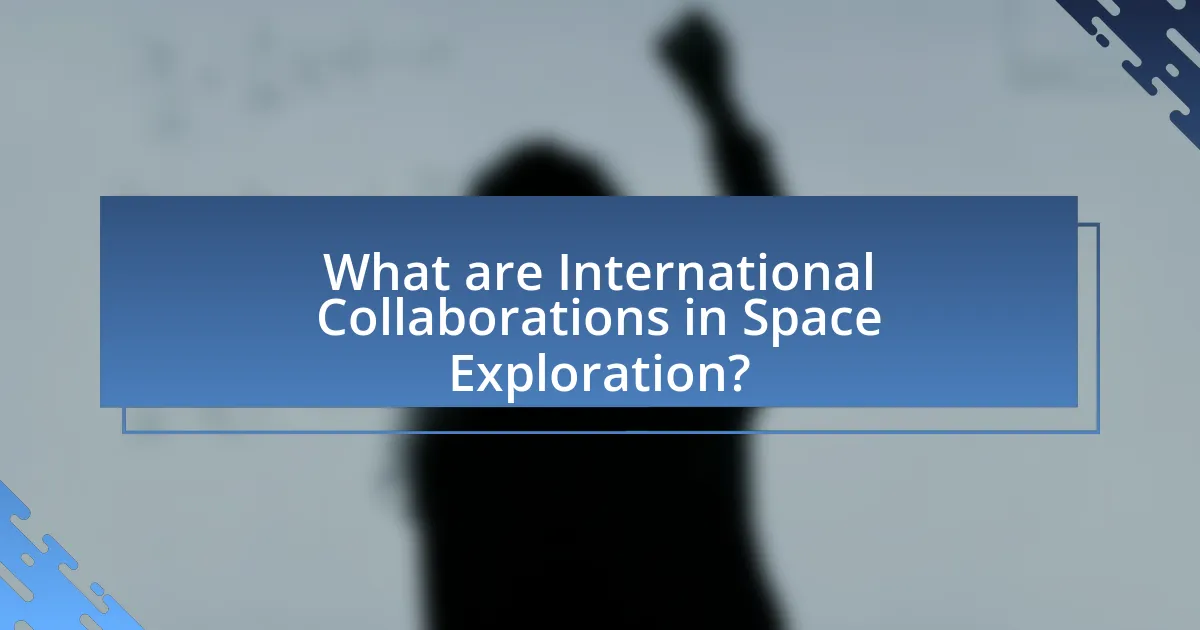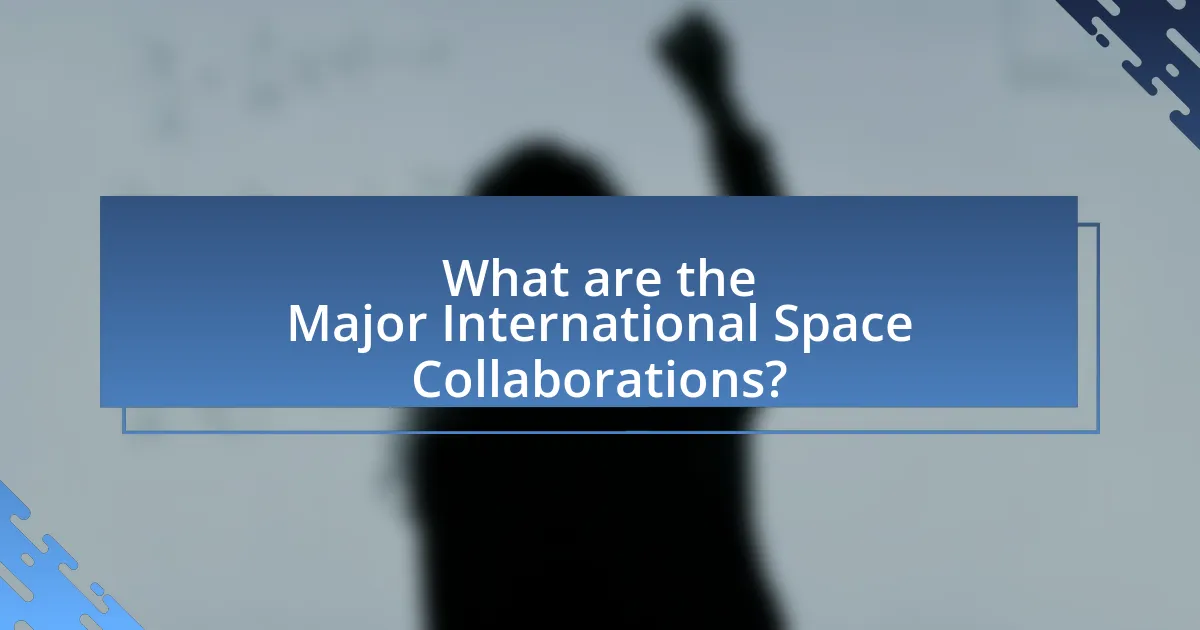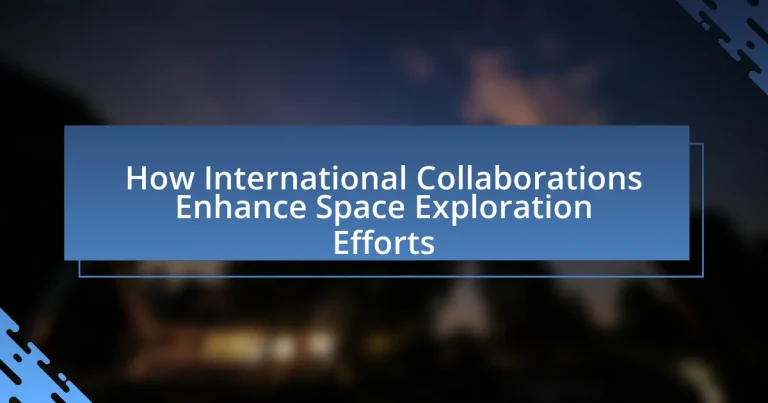International collaborations in space exploration involve cooperative efforts among various countries and their space agencies to conduct research, share resources, and execute missions beyond Earth. These partnerships, exemplified by the International Space Station (ISS), enhance capabilities by pooling financial, technological, and human resources, leading to significant advancements in space science and technology. The article explores how these collaborations form, the roles of governmental and non-governmental organizations, the importance of shared resources, and the benefits of working together on space missions. It also highlights major international collaborations, successful missions, and best practices for improving communication and coordination among partners, ultimately demonstrating how collective efforts address challenges and drive innovation in space exploration.

What are International Collaborations in Space Exploration?
International collaborations in space exploration refer to cooperative efforts between multiple countries and their space agencies to conduct research, share resources, and execute missions beyond Earth. These collaborations enhance capabilities by pooling financial, technological, and human resources, exemplified by projects like the International Space Station (ISS), which involves space agencies from the United States, Russia, Europe, Japan, and Canada, facilitating scientific research and technological development in a shared environment. Such partnerships have led to significant advancements in space science, including joint missions to Mars and the Moon, demonstrating the effectiveness of collaborative approaches in overcoming the challenges of space exploration.
How do international collaborations form in the context of space exploration?
International collaborations in space exploration form through shared goals, mutual interests, and the pooling of resources among countries. These collaborations often begin with bilateral or multilateral agreements, where nations identify common objectives such as scientific research, technology development, or planetary exploration. For instance, the International Space Station (ISS) is a prime example, involving partnerships between NASA, Roscosmos, ESA, JAXA, and CSA, which collectively contribute funding, technology, and expertise. Such collaborations are further facilitated by international treaties like the Outer Space Treaty of 1967, which promotes peaceful exploration and cooperation in space activities.
What roles do space agencies play in these collaborations?
Space agencies play crucial roles in international collaborations by facilitating resource sharing, expertise exchange, and joint mission planning. For instance, NASA, ESA, and Roscosmos have collaborated on projects like the International Space Station (ISS), which exemplifies how agencies pool funding, technology, and scientific knowledge to achieve common goals. This collaboration enhances the capabilities of each agency, allowing for more ambitious missions and the advancement of space science. The ISS, operational since 1998, serves as a testament to the effectiveness of such partnerships, demonstrating that collective efforts can lead to significant advancements in human space exploration and research.
How do governmental and non-governmental organizations contribute?
Governmental and non-governmental organizations contribute to space exploration by providing funding, expertise, and collaborative frameworks that enhance research and development. For instance, NASA, a governmental organization, allocates billions of dollars annually to various space missions, while non-governmental organizations like SpaceX innovate through private funding and partnerships, significantly reducing launch costs. These collaborations often lead to shared resources and knowledge, exemplified by the International Space Station, which involves multiple countries and organizations working together to advance scientific understanding and technology in space.
Why are international collaborations important for space exploration?
International collaborations are important for space exploration because they pool resources, expertise, and technology from multiple countries, enhancing the overall capability and efficiency of missions. For instance, the International Space Station (ISS) is a prime example, involving contributions from 15 nations, which has led to advancements in scientific research and technology development that no single country could achieve alone. Additionally, collaborative efforts reduce costs and risks associated with space missions, as seen in joint projects like the Mars Rover missions, where shared funding and knowledge have accelerated progress and innovation in planetary exploration.
What are the key benefits of working together on space missions?
The key benefits of working together on space missions include enhanced resource sharing, increased scientific knowledge, and improved technological advancements. Collaborative efforts allow countries to pool financial resources, reducing individual costs and enabling larger, more ambitious projects, such as the International Space Station, which involves multiple nations and has led to significant advancements in human spaceflight and research. Additionally, international partnerships foster diverse perspectives and expertise, leading to innovative solutions and discoveries, as evidenced by joint missions like the Mars Science Laboratory, which combined efforts from NASA and international partners to achieve successful exploration of the Martian surface.
How do these collaborations enhance scientific research and technology development?
Collaborations enhance scientific research and technology development by pooling resources, expertise, and diverse perspectives from multiple institutions and countries. This collective approach accelerates innovation, as seen in projects like the International Space Station (ISS), where contributions from NASA, ESA, Roscosmos, JAXA, and CSA have led to advancements in life sciences, materials science, and robotics. The ISS has facilitated over 3,000 research investigations, demonstrating how shared knowledge and infrastructure can lead to breakthroughs that individual entities might struggle to achieve alone.

What are the Major International Space Collaborations?
Major international space collaborations include the International Space Station (ISS), the European Space Agency (ESA), and the Artemis program. The ISS, a partnership among NASA, Roscosmos, ESA, JAXA, and CSA, serves as a microgravity research laboratory and has been continuously inhabited since 2000. The ESA, established in 1975, collaborates with various countries on missions such as Mars exploration and Earth observation. The Artemis program, involving NASA and international partners, aims to return humans to the Moon by 2024 and establish a sustainable presence there. These collaborations enhance technological advancements, share costs, and foster international cooperation in space exploration.
Which countries are leading in international space collaborations?
The United States, Russia, and members of the European Space Agency (ESA) are leading in international space collaborations. The United States, through NASA, has established partnerships with countries such as Japan, Canada, and various European nations for projects like the International Space Station (ISS). Russia has a long history of collaboration, particularly with the United States and ESA, in human spaceflight and scientific research. ESA, which includes 22 member states, actively collaborates with NASA and other international partners on missions like Mars exploration and Earth observation programs. These collaborations enhance technological advancements and share costs and expertise, significantly contributing to global space exploration efforts.
What are the notable partnerships between space agencies?
Notable partnerships between space agencies include the collaboration between NASA and the European Space Agency (ESA) on the Hubble Space Telescope, which has provided significant astronomical discoveries since its launch in 1990. Another key partnership is the International Space Station (ISS), involving NASA, ESA, Roscosmos (Russia), JAXA (Japan), and CSA (Canada), which has facilitated extensive scientific research and international cooperation in low Earth orbit since its first module was launched in 1998. Additionally, the Mars Exploration Program sees collaboration between NASA and ESA, particularly in missions like the Mars Sample Return initiative, aimed at returning samples from Mars to Earth. These partnerships exemplify how international collaboration enhances capabilities and expands the scope of space exploration efforts.
How do these partnerships influence global space policies?
Partnerships in space exploration significantly influence global space policies by fostering collaborative frameworks that establish shared standards and regulations. For instance, international agreements like the Outer Space Treaty of 1967, which was shaped by collaborative efforts among nations, set foundational principles for the peaceful use of outer space. These partnerships encourage the exchange of technology and knowledge, leading to harmonized policies that address issues such as space debris management and satellite communications. Furthermore, collaborative missions, such as the International Space Station, exemplify how joint efforts can lead to unified approaches in policy-making, ensuring that participating countries adhere to common safety and operational protocols.
What are some successful examples of international space missions?
Some successful examples of international space missions include the International Space Station (ISS), the Mars Science Laboratory (Curiosity Rover), and the Hubble Space Telescope. The ISS, a collaboration between NASA, Roscosmos, ESA, JAXA, and CSA, has been continuously inhabited since 2000, facilitating numerous scientific experiments in microgravity. The Mars Science Laboratory, which includes the Curiosity Rover, was a joint effort by NASA and international partners, successfully landing on Mars in 2012 to explore the planet’s geology and climate. The Hubble Space Telescope, launched in 1990 through a collaboration between NASA and ESA, has provided groundbreaking astronomical observations, significantly advancing our understanding of the universe.
How did the International Space Station exemplify collaboration?
The International Space Station exemplified collaboration by uniting multiple countries and space agencies to work on a shared scientific platform. This partnership includes contributions from NASA (United States), Roscosmos (Russia), ESA (European Space Agency), JAXA (Japan), and CSA (Canada), which collectively manage the station’s operations and research initiatives. The ISS has facilitated over 2,000 scientific investigations since its launch in 1998, showcasing how international teamwork can advance knowledge in fields such as biology, physics, and Earth science. This collaborative effort not only enhances technological development but also fosters peaceful relations among nations through shared goals in space exploration.
What lessons were learned from the Mars exploration collaborations?
Mars exploration collaborations have demonstrated the importance of international partnerships in advancing scientific knowledge and technological capabilities. These collaborations have highlighted that pooling resources and expertise from multiple countries leads to more comprehensive mission planning and execution, as seen in projects like the Mars Science Laboratory and the Mars 2020 Perseverance rover, which involved contributions from NASA, ESA, and other space agencies. Furthermore, these partnerships have shown that sharing data and findings accelerates innovation and fosters a global scientific community, ultimately enhancing the effectiveness of space exploration efforts.

How do International Collaborations Enhance Space Exploration Efforts?
International collaborations enhance space exploration efforts by pooling resources, expertise, and technology from multiple countries, leading to more ambitious and cost-effective missions. For instance, the International Space Station (ISS) is a prime example, where collaboration between NASA, Roscosmos, ESA, JAXA, and CSA has enabled continuous human presence in low Earth orbit since 2000, facilitating scientific research that no single nation could achieve alone. Additionally, joint missions like the Mars Science Laboratory, involving contributions from various international space agencies, demonstrate how shared knowledge accelerates technological advancements and reduces individual costs, ultimately expanding the scope and scale of exploration initiatives.
What technological advancements have resulted from international collaborations?
International collaborations have led to significant technological advancements in space exploration, including the development of the International Space Station (ISS), advancements in satellite technology, and enhanced deep space exploration capabilities. The ISS, a joint project involving NASA, Roscosmos, ESA, JAXA, and CSA, serves as a microgravity research laboratory and has facilitated over 20 years of scientific research in space. Additionally, collaborative efforts have resulted in improved satellite systems, such as the Global Positioning System (GPS), which integrates contributions from multiple countries to provide precise navigation data. Furthermore, international partnerships have enabled missions like the Mars Rover, which combines expertise and resources from various nations, enhancing our ability to explore and understand other planets. These examples illustrate how global cooperation in space has driven technological progress and expanded the frontiers of human knowledge.
How do shared resources improve mission outcomes?
Shared resources improve mission outcomes by enabling collaborative access to advanced technologies, expertise, and funding, which enhances overall mission efficiency and effectiveness. For instance, international partnerships in space exploration, such as the collaboration between NASA and ESA on the Mars rover missions, allow for the pooling of scientific knowledge and technological capabilities, resulting in more robust mission designs and successful outcomes. This collaborative approach has been shown to reduce costs and risks while increasing the likelihood of achieving mission objectives, as evidenced by the successful deployment of the Mars Perseverance rover, which benefited from shared engineering and scientific resources across multiple space agencies.
What innovations have emerged from collaborative projects?
Collaborative projects in space exploration have led to significant innovations such as the development of the International Space Station (ISS), which serves as a microgravity research laboratory. The ISS exemplifies how international partnerships can pool resources and expertise, resulting in advancements in life sciences, materials science, and technology. For instance, the collaboration between NASA, Roscosmos, ESA, JAXA, and CSA has facilitated over 20 years of continuous human presence in space, enabling groundbreaking research that has contributed to advancements in satellite technology and Earth observation systems. These innovations demonstrate the effectiveness of collaborative efforts in driving progress in space exploration.
How do international collaborations address challenges in space exploration?
International collaborations address challenges in space exploration by pooling resources, expertise, and technology from multiple countries, which enhances mission capabilities and reduces costs. For instance, the International Space Station (ISS) is a prime example where 15 nations, including the United States, Russia, and members of the European Space Agency, collaborate to conduct scientific research and develop technologies that would be prohibitively expensive for any single nation. This partnership allows for shared funding, diversified scientific input, and a broader range of technological advancements, ultimately leading to more successful missions and innovative solutions to complex problems in space exploration.
What are the common challenges faced in space missions?
Common challenges faced in space missions include technical failures, budget constraints, and human factors. Technical failures can arise from equipment malfunctions, as seen in the Mars Climate Orbiter mission, which failed due to a navigation error caused by a unit conversion mistake. Budget constraints often limit the scope and duration of missions, impacting research and development; for instance, NASA’s budget cuts have led to delays in various projects. Human factors, such as psychological stress and physical health issues, can affect astronaut performance, highlighted by studies from the National Aeronautics and Space Administration that show the impact of long-duration spaceflight on mental health.
How do partnerships help mitigate risks and costs?
Partnerships help mitigate risks and costs by distributing financial burdens and sharing expertise among collaborating entities. In the context of space exploration, organizations like NASA and ESA often pool resources, which reduces individual investment and lowers the overall financial risk associated with missions. For example, the International Space Station (ISS) is a product of multiple space agencies working together, which has significantly decreased the costs of development and maintenance compared to if each agency operated independently. This collaborative approach not only enhances resource efficiency but also combines diverse technological capabilities, leading to more innovative solutions and reduced likelihood of mission failure.
What best practices can enhance future international collaborations in space exploration?
Establishing clear communication protocols is a best practice that can enhance future international collaborations in space exploration. Effective communication ensures that all parties understand objectives, timelines, and responsibilities, which is crucial for coordinating complex missions. For instance, the International Space Station (ISS) program has successfully utilized structured communication frameworks among its international partners, leading to over 20 years of collaborative research and development. Additionally, fostering mutual respect and cultural understanding among diverse teams can improve collaboration outcomes, as evidenced by the successful partnerships formed during the Mars rover missions, where scientists from various countries worked together to share data and insights. Implementing these practices can significantly increase the efficiency and success of international space exploration efforts.
How can communication and coordination be improved among international partners?
Communication and coordination among international partners can be improved through the establishment of standardized protocols and regular joint meetings. Standardized protocols ensure that all parties have a clear understanding of communication methods, timelines, and responsibilities, which minimizes misunderstandings. Regular joint meetings, whether virtual or in-person, foster relationship-building and allow for real-time updates on project progress, challenges, and solutions. For instance, the International Space Station (ISS) program exemplifies effective communication through its structured meetings and shared operational guidelines, which have facilitated collaboration among multiple space agencies, including NASA, ESA, and Roscosmos. This structured approach has led to successful missions and enhanced cooperation in space exploration efforts.
What strategies can be implemented to foster trust and collaboration?
To foster trust and collaboration in international space exploration efforts, organizations should implement transparent communication, establish shared goals, and engage in joint problem-solving. Transparent communication ensures that all parties are informed and aligned, reducing misunderstandings and building confidence. Establishing shared goals creates a common purpose, motivating teams to work together effectively. Engaging in joint problem-solving encourages collaboration by leveraging diverse perspectives and expertise, which can lead to innovative solutions. For instance, the International Space Station (ISS) program exemplifies these strategies, as it involves multiple countries working together with clear objectives and open lines of communication, resulting in successful missions and advancements in space research.


